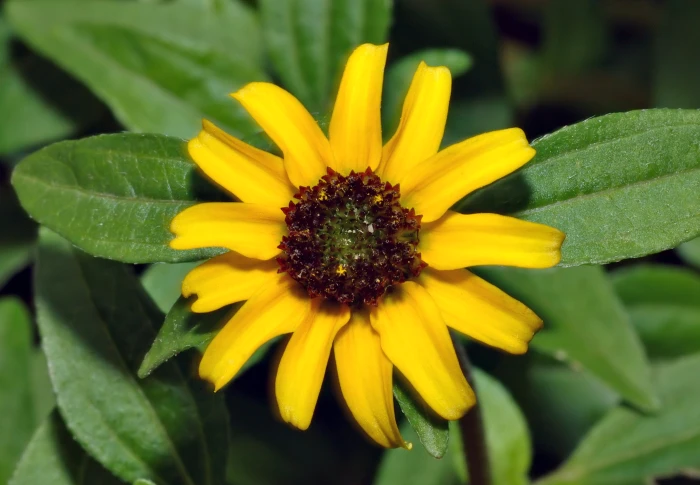Mexican Creeping Zinnia
(Sanvitalia procumbens)
Mexican Creeping Zinnia (Sanvitalia procumbens)
/
/

André Karwath aka Aka
CC BY-SA 2.5
Image By:
André Karwath aka Aka
Recorded By:
Copyright:
CC BY-SA 2.5
Copyright Notice:
Photo by: André Karwath aka Aka | License Type: CC BY-SA 2.5 | License URL: https://creativecommons.org/licenses/by-sa/2.5 | Uploader: Aka | Publisher: Wikimedia Commons | Title: Sanvitalia_procumbens_-_blossom_(aka).jpg |















































Estimated Native Range
Climate Requirements
| • Precipitation | 21" - 25" |
| • High Temp. | 73°F - 95°F |
| • Low Temp. | 25°F - 56°F |
Summary
Sanvitalia procumbens, commonly known as Mexican Creeping Zinnia, is an annual herb native to open woodlands and scrub areas in Mexico and Guatemala. It is a low-growing plant that typically reaches a height of 0.3-0.5 feet (0.09-0.15 meters) and spreads 0.8-2 feet (0.24-0.61 meters) wide. The plant forms a mat-like ground cover with small, lance-shaped leaves and produces a profusion of daisy-like flowers with yellow centers and brown, yellow, orange, or purple rays throughout the summer and fall. The flowers are highly attractive to pollinators and add a splash of color to garden beds.
Mexican Creeping Zinnia is valued for its drought tolerance and its ability to thrive in hot, sunny conditions, making it an excellent choice for rock gardens, borders, and containers. It is also used as a ground cover to suppress weeds and prevent soil erosion. This plant prefers well-drained soils and is relatively low-maintenance, requiring minimal watering once established. While it is not prone to serious pests or diseases, it can occasionally suffer from powdery mildew in humid conditions. Mexican Creeping Zinnia is not known for being invasive and can be easily managed in a garden setting.CC BY-SA 4.0
Mexican Creeping Zinnia is valued for its drought tolerance and its ability to thrive in hot, sunny conditions, making it an excellent choice for rock gardens, borders, and containers. It is also used as a ground cover to suppress weeds and prevent soil erosion. This plant prefers well-drained soils and is relatively low-maintenance, requiring minimal watering once established. While it is not prone to serious pests or diseases, it can occasionally suffer from powdery mildew in humid conditions. Mexican Creeping Zinnia is not known for being invasive and can be easily managed in a garden setting.CC BY-SA 4.0
Plant Description
- Plant Type: Herb
- Height: 0.3-0.5 feet
- Width: 0.8-1.5 feet
- Growth Rate: Moderate
- Flower Color: Brown, Yellow
- Flowering Season: Summer, Fall
- Leaf Retention:
Growth Requirements
- Sun: Full Sun
- Water: Medium
- Drainage: Medium
Common Uses
Bank Stabilization, Bee Garden, Border Plant, Deer Resistant, Drought Tolerant, Groundcover, Low Maintenance, Potted Plant, Rock Garden, Showy Flowers, Street Planting
Natural Habitat
Native to open woodlands and scrub areas in Mexico and Guatemala
Other Names
Common Names: Mexican Creeping-Zinnia, Creeping-Zinnia, Husarenknopf, Husarenknöpfchen, Husarknappar
Scientific Names: Sanvitalia procumbens, Sanvitalia villosa, Sanvitalia acinifolia, Sanvitalia procumbens var. oblongifolia, Zexmenia thysanocarpa, Lorentea atropurpurea, Laurentia atropurpurea, Sanvitalia procumbens subsp. oblongifolia, Sanvitalia procumbens var. procumbens
GBIF Accepted Name: Sanvitalia procumbens Lam.